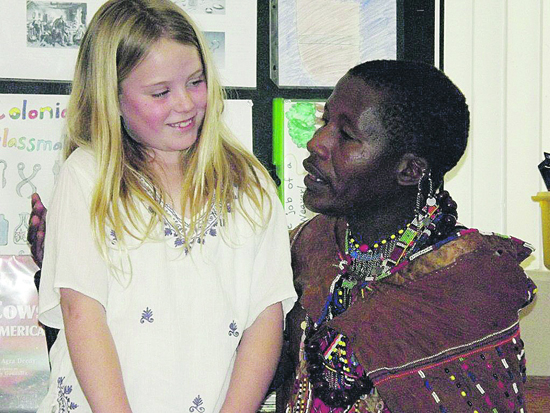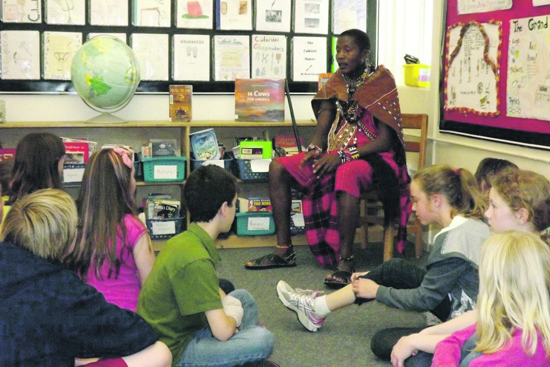 | | | Lila Chatterton, 5th grade, listens closely to her Maasai "rafiki", or friend, Salaton Ole Ntutu. Photos Cathy Dausman
| | | | | | With a hearty "Jambo!" (hello) Salaton Ole Ntutu strode into two Burton Valley Elementary classrooms on a visit February 21. The Maasai tribesman had travelled halfway across the world to share stories of life in East Africa's Republic of Kenya, fundraise for widows and education within his village and promote eco-tourism.
 Dressed in red robes (which he called "a powerful color") and adorned with a sheepskin and jewelry made by villagers, Ntutu carried a staff and buffalo tail, and quickly made "rafiki" (friends) with the students.
Dressed in red robes (which he called "a powerful color") and adorned with a sheepskin and jewelry made by villagers, Ntutu carried a staff and buffalo tail, and quickly made "rafiki" (friends) with the students.
 In Meredith Dolley's first grade class he spoke of the Maasai's coexistence amid legendary big game animals like the lion, rhino, elephant and buffalo. In answer to one student's question, Ntutu said he has killed seven lions, but only in self-defense. "[Maasai] Warriors don't fight," he said simply.
In Meredith Dolley's first grade class he spoke of the Maasai's coexistence amid legendary big game animals like the lion, rhino, elephant and buffalo. In answer to one student's question, Ntutu said he has killed seven lions, but only in self-defense. "[Maasai] Warriors don't fight," he said simply.
 Ntutu taught students how to count in Swahili, how to imitate the "generous" hyena's call, showed them a Maasai dance and reminded each to "listen to your elders". He told them village children their age (6 or 7) are expected to tend their family's cattle or sheep during the day.
Ntutu taught students how to count in Swahili, how to imitate the "generous" hyena's call, showed them a Maasai dance and reminded each to "listen to your elders". He told them village children their age (6 or 7) are expected to tend their family's cattle or sheep during the day.
 Fifth graders in Claudia Norton's class inquired about Ntutu's siblings - he is the youngest of six, in a family of three boys, three girls- his two children, and asked him how old he is. "I don't know," he said honestly, explaining that the Maasai tie age to events in nature, like floods or droughts. Ntutu's passport lists his birth date as Dec 24, 1971. But Ntutu knows that is incorrect, because it would make him older than the birth dates his siblings have listed on their government IDs.
Fifth graders in Claudia Norton's class inquired about Ntutu's siblings - he is the youngest of six, in a family of three boys, three girls- his two children, and asked him how old he is. "I don't know," he said honestly, explaining that the Maasai tie age to events in nature, like floods or droughts. Ntutu's passport lists his birth date as Dec 24, 1971. But Ntutu knows that is incorrect, because it would make him older than the birth dates his siblings have listed on their government IDs.
 The Maasai classify themselves simply, as a child, a warrior or an elder. Ntutu is an elder. Villagers carry their "bedding" (a blanket) with them; it is wrapped around their shoulders and worn as clothing during the day. They bring their cattle inside huts to sleep at night. A typical morning for Ntutu might include a breakfast of maize paste, some work as a medicine man, and some time spent overseeing village affairs.
The Maasai classify themselves simply, as a child, a warrior or an elder. Ntutu is an elder. Villagers carry their "bedding" (a blanket) with them; it is wrapped around their shoulders and worn as clothing during the day. They bring their cattle inside huts to sleep at night. A typical morning for Ntutu might include a breakfast of maize paste, some work as a medicine man, and some time spent overseeing village affairs.
 Before leaving the classroom, Salaton Ole Ntutu laid his hands atop each student's head and bestowed a "sopa" or blessing. Lastly, he questioned his audience: "Do you know what color a zebra is?" The answers, both black and white, brought a smile to his face. After interlacing his fingers with those of a fair skinned student, Ntutu proclaimed: "Then we are zebras too!"
Before leaving the classroom, Salaton Ole Ntutu laid his hands atop each student's head and bestowed a "sopa" or blessing. Lastly, he questioned his audience: "Do you know what color a zebra is?" The answers, both black and white, brought a smile to his face. After interlacing his fingers with those of a fair skinned student, Ntutu proclaimed: "Then we are zebras too!"
 Ntutu was hosted in the Bay area by Susan Olofson (http://www.susanolofson.com/index.htm)
Ntutu was hosted in the Bay area by Susan Olofson (http://www.susanolofson.com/index.htm)
 He was invited to speak at Burton Valley Elementary through his connection with Gail McCormick, a board chairman of the nonprofit Jamii Moja (www.jamiimoja.org). McCormick has two grandchildren attending Burton Valley Elementary.
He was invited to speak at Burton Valley Elementary through his connection with Gail McCormick, a board chairman of the nonprofit Jamii Moja (www.jamiimoja.org). McCormick has two grandchildren attending Burton Valley Elementary.

|

